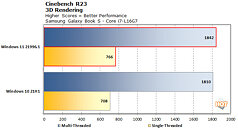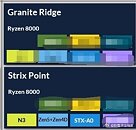
AMD "Strix Point" Zen 5 Monolithic Silicon has a 12-core CPU?
It looks like the monolithic silicon that succeeds "Phoenix," codenamed "Strix Point," will finally introduce an increase in CPU core counts for the thin-and-light and ultraportable mobile platforms. "Strix Point" is codename for the next-generation APU die being developed at AMD, which, according to a leaked MilkyWay@Home benchmark result, comes with a 12-core/24-thread CPU.
The silicon is identified by MilkyWay@Home with the OPN "AMD Eng Sample: 100-000000994-03_N," and CPU identification string "AuthenticAMD Family 26 Model 32 Stepping 0 -> B20F00." The "Strix Point" CPU could be the second time AMD has increased CPU core-counts per CCX. From "Zen 3" onward, the company increased the cores per CCX from 4 to 8, allowing a single "Zen 3" CCX on the "Cezanne" monolithic silicon to come with 8 cores. It's highly likely that with "Zen 5," the company is increasing the cores/CCX to 12, and that "Strix Point" has one of these CCXs.
The silicon is identified by MilkyWay@Home with the OPN "AMD Eng Sample: 100-000000994-03_N," and CPU identification string "AuthenticAMD Family 26 Model 32 Stepping 0 -> B20F00." The "Strix Point" CPU could be the second time AMD has increased CPU core-counts per CCX. From "Zen 3" onward, the company increased the cores per CCX from 4 to 8, allowing a single "Zen 3" CCX on the "Cezanne" monolithic silicon to come with 8 cores. It's highly likely that with "Zen 5," the company is increasing the cores/CCX to 12, and that "Strix Point" has one of these CCXs.










